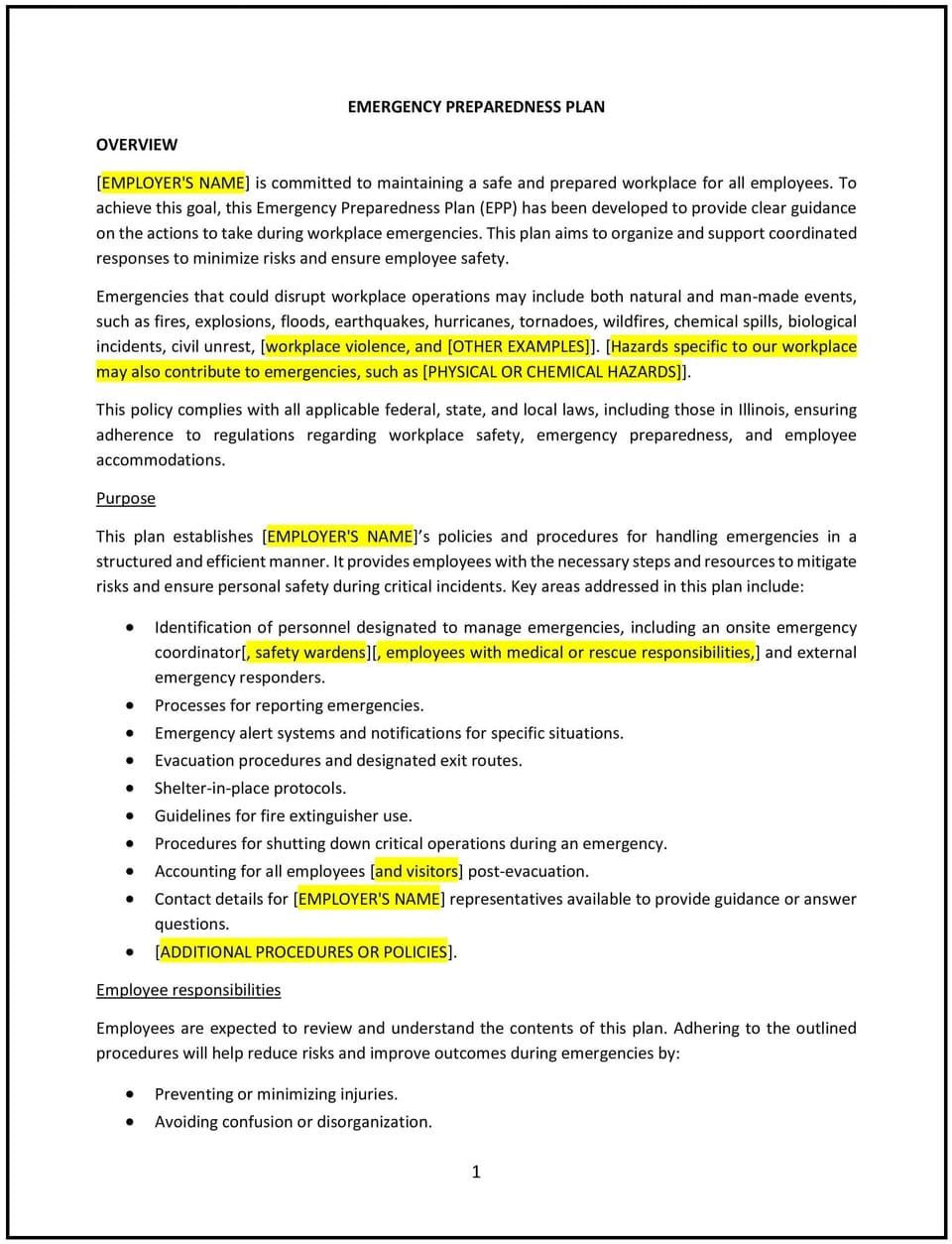Emergency preparedness plan (Illinois): Free template

Emergency preparedness plan (Illinois)
This emergency preparedness plan is designed to help Illinois businesses create effective strategies for responding to emergencies, such as natural disasters, fires, workplace accidents, or other crises. It outlines procedures for safeguarding employees, minimizing risks, and ensuring business continuity in compliance with Illinois safety regulations.
By adopting this plan, businesses can protect their workforce, reduce disruptions, and maintain operational stability.
How to use this emergency preparedness plan (Illinois)
- Identify potential emergencies: List possible scenarios, such as severe weather, fires, medical emergencies, or power outages, relevant to the business location and industry.
- Develop response procedures: Outline step-by-step actions for each type of emergency, including evacuation routes, shelter-in-place protocols, and communication plans.
- Assign responsibilities: Designate roles for emergency coordinators, team leaders, and employees to ensure clear accountability during crises.
- Provide emergency contact information: Include a list of essential contacts, such as local emergency services, utility providers, and internal response teams.
- Address employee safety: Specify procedures for assisting individuals with disabilities or special needs during emergencies.
- Conduct regular training: Offer drills and training sessions to ensure employees understand emergency procedures and their roles.
- Include communication plans: Establish methods for notifying employees, customers, and stakeholders during and after an emergency.
- Monitor compliance: Ensure the plan aligns with Illinois Occupational Safety and Health Administration (OSHA) regulations and other applicable laws.
Benefits of using this emergency preparedness plan (Illinois)
This plan provides several benefits for Illinois businesses:
- Protects employees: Safeguards the health and safety of employees during emergencies.
- Minimizes disruptions: Helps maintain business continuity by preparing for various scenarios.
- Enhances compliance: Supports alignment with Illinois safety regulations and OSHA requirements.
- Promotes confidence: Reassures employees, customers, and stakeholders that the business is prepared for emergencies.
- Reduces risks: Mitigates potential damage to property, equipment, and operations.
Tips for using this emergency preparedness plan (Illinois)
- Communicate the plan: Share the plan with employees during onboarding and ensure it is easily accessible in the workplace.
- Conduct regular drills: Schedule fire drills, evacuation practices, and other exercises to reinforce employee preparedness.
- Review and update: Revise the plan periodically to reflect changes in Illinois regulations, workplace conditions, or identified risks.
- Collaborate with local authorities: Work with fire departments, police, and emergency services to develop effective response procedures.
- Address special needs: Include tailored protocols for assisting individuals with disabilities or language barriers during emergencies.
Q: What types of emergencies are covered under this plan?
A: The plan addresses natural disasters, fires, medical emergencies, power outages, and other crises relevant to the business and its location.
Q: How are employees notified during an emergency?
A: Employees are notified through designated communication methods, such as phone alerts, email notifications, or PA systems.
Q: Who is responsible for implementing emergency procedures?
A: Emergency coordinators, team leaders, and other designated personnel are responsible for managing procedures and ensuring employee safety.
Q: How often should drills and training sessions be conducted?
A: Drills and training sessions should be conducted at least annually or more frequently based on specific risks or regulatory requirements.
Q: Are special accommodations included in the plan?
A: Yes, the plan includes procedures for assisting individuals with disabilities or other special needs during emergencies.
Q: How does the plan align with Illinois regulations?
A: The plan complies with Illinois OSHA regulations and other safety requirements to ensure legal and operational alignment.
Q: How often is this plan reviewed?
A: The plan is reviewed annually or whenever significant changes occur in Illinois laws, workplace conditions, or risk assessments.
Q: What should employees do if they identify a new risk?
A: Employees should report new risks to their manager or the designated emergency coordinator to ensure the plan is updated appropriately.
This article contains general legal information and does not contain legal advice. Cobrief is not a law firm or a substitute for an attorney or law firm. The law is complex and changes often. For legal advice, please ask a lawyer.


